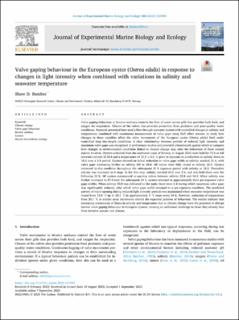| dc.contributor.author | Bamber, Shaw Duncan | |
| dc.date.accessioned | 2024-04-10T10:26:32Z | |
| dc.date.available | 2024-04-10T10:26:32Z | |
| dc.date.created | 2023-09-22T13:30:29Z | |
| dc.date.issued | 2023 | |
| dc.identifier.citation | Journal of Experimental Marine Biology and Ecology. 2023, 568 . | en_US |
| dc.identifier.issn | 0022-0981 | |
| dc.identifier.uri | https://hdl.handle.net/11250/3125766 | |
| dc.description.abstract | Valve gaping behaviour in bivalve molluscs controls the flow of water across gills that provides both food, and oxygen for respiration. Closure of the valves also provides protection from predators and poor-quality water conditions. Research presented here used a flow through seawater system with controlled changes in salinity and temperature, combined with continuous measurement of valve gape using Hall effect sensors, to study how changes in these variables affect the valve movements of the European oyster (Ostrea edulis) held under controlled long day-length conditions. A clear relationship between periods of reduced light intensity and maximum valve gape was recognised in preliminary studies and provided a benchmark against which to compare how changes in environmental conditions linked to climate change may alter the behaviour of these coastal marine bivalves. Oysters collected from the southwest coast of Norway in August 2022 were held for 72 h at full seawater salinity of 33.6 and a temperature of 15.8 ± 0.5 °C prior to exposure to a reduction in salinity down to 18.2 over a 3 h period. Oysters showed an initial reduction in valve gape width as salinity reached 31.4, with valve gape decreasing further as salinity fell to 28.8. All valves were fully closed at salinity 20.5. Oysters remained in this condition throughout the subsequent 21 h exposure period with salinity at 18.2. Thereafter salinity was increased in 3 steps. In the first step, salinity reached 24.2 over 2 h, and was held there over the following 22 h. All oysters commenced re-opening valves between salinity 22.8 and 24.2. When salinity was further increased to 27.3 over the subsequent 24 h, oysters returned to approximately their pre-exposure valve gape widths. When salinity 33.8 was delivered to the tanks there were 2 d during which maximum valve gape was significantly reduced, after which valve gape width returned to a pre-exposure condition. The predicted pattern of valve opening during reduced light intensity periods was maintained when seawater temperature was raised from 15.8 °C up to 20.1 °C in approximately 1 °C steps every 24 h. However, reduction of temperature from 20.1 °C in similar sized increments altered the expected patterns of behaviour. The results indicate that increasing occurrences of fluxes in salinity and temperature due to climate change have the potential to disrupt normal valve gaping behaviour in European oysters, creating an additional challenge to those they already face from invasive species and disease. | |
| dc.language.iso | eng | en_US |
| dc.rights | Navngivelse 4.0 Internasjonal | * |
| dc.rights.uri | http://creativecommons.org/licenses/by/4.0/deed.no | * |
| dc.title | Valve gaping behaviour in the European oyster (Ostrea edulis) in response to changes in light intensity when combined with variations in salinity and seawater temperature | en_US |
| dc.title.alternative | Valve gaping behaviour in the European oyster (Ostrea edulis) in response to changes in light intensity when combined with variations in salinity and seawater temperature | en_US |
| dc.type | Journal article | en_US |
| dc.type | Peer reviewed | en_US |
| dc.description.version | publishedVersion | |
| cristin.ispublished | true | |
| cristin.fulltext | original | |
| cristin.qualitycode | 1 | |
| dc.identifier.doi | 10.1016/j.jembe.2023.151943 | |
| dc.identifier.cristin | 2177954 | |
| dc.source.journal | Journal of Experimental Marine Biology and Ecology | en_US |
| dc.source.volume | 568 | en_US |
| dc.source.pagenumber | 10 | en_US |
| dc.relation.project | EC/H2020/863034 | |

